Introduction - Destinations of Leavers Longitudinal survey 2006/07
This report presents findings from the Destinations of Leavers from Higher Education (DLHE) Longitudinal Survey conducted during winter 2010/11. The survey was carried out among the cohort of students who completed a higher education course at a higher education institution in the UK in 2006/07. The aim of the survey was to collect information on the activities of leavers approximately 3.5 years after leaving higher education.
The DLHE Survey is carried out by the Higher Education Statistics Agency (HESA), the central source for the collection and dissemination of statistics about publicly funded higher education in the UK. There are two stages to the survey. The first stage is a census of individuals who have completed higher education courses in the UK. This stage is carried out approximately six months after the courses end and is referred to as the Early Survey.
The second stage is a follow-up survey that looks at the destinations of leavers up to 3.5 years after they qualified. This stage is referred to as the Longitudinal Survey. The Longitudinal Survey, by contrast, is not a census survey but is instead based on a sample of the students who responded to the corresponding Early Survey. 49,065 leavers responded to the Longitudinal survey, an overall response rate of 22.2% of all those with contact details. The survey asked a wide range of questions about the activities leavers were undertaking on 29 November 2010. Further information about the sample design and survey methodology are provided in the definitions section.
Report structure and conventions
Throughout the report, references are made to tables; this series of Excel tables can be downloaded individually from the links within this introduction or as an entire set from the contents page.
Throughout the report 2006/07 refers to the cohort who left higher education in 2006/07, took part in the Early DLHE Survey six months later and then answered questions about their activities on 29 November 2010. 2004/05 refers to the cohort who left higher education in 2004/05, took part in the Early DLHE Survey six months later and then answered questions about their activities on 24 November 2008. 2002/03 refers to those who left higher education in 2002/03, took part in the Early DLHE Survey six months later and who took part in the first ever DLHE Longitudinal Survey answering questions about their activity on 27 November 2006.
Base numbers shown in the tables and charts represent weighted populations and reflect numbers of leavers who answered particular questions in the survey, hence these may differ between charts and tables. Base numbers have been rounded to the nearest multiple of 5.
Percentages have been calculated on weighted data, but have been suppressed (and shown as ‘..’ in tabulations) if the unweighted underlying population is between 0 and 52 inclusive. Percentages in charts and tables are rounded to one decimal place, therefore percentages may not sum to exactly 100%.
Overview
UK and EU domicile leavers
Chart 1 below illustrates the trends in the main activities of leavers 3.5 years after leaving HE for the past three Longitudinal Surveys (sourced from Table 1). The percentage of leavers working (either Full-time paid work including self employed, part-time paid work, voluntary work or unpaid work) at the survey date has decreased slightly to 80.8% for 2006/07 from 82.8% for 2004/05 leavers. The 2006/07 percentage is similar to that observed for 2002/03 leavers of 80.5%. The proportion of leavers assumed to be unemployed has gradually increased as has the percentage of leavers engaged in further study only. A new activity ‘Creating a portfolio’ was added to the questionnaire for 2006/07 which 0.4% of leavers indicated was their main activity. In all charts leavers ‘Creating a portfolio’ are grouped in ‘All other’ with leavers ‘Not available for employment’ and ‘Other’.
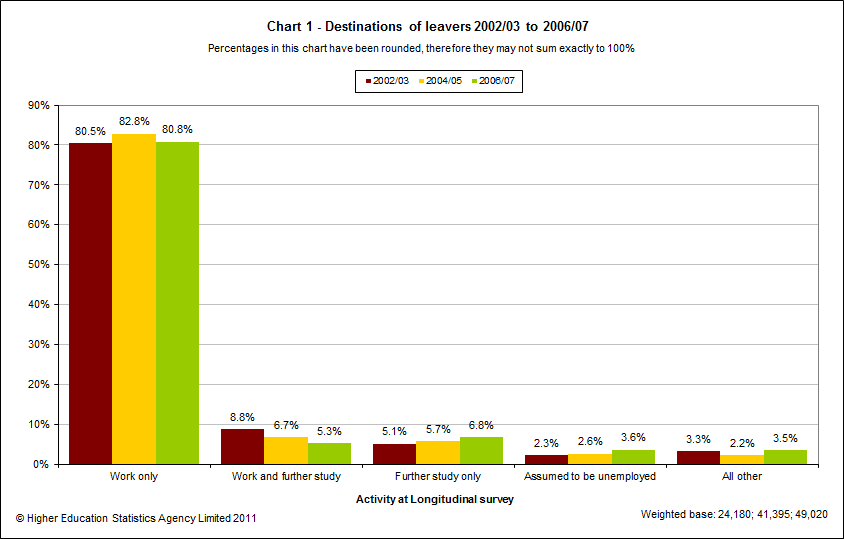
Charts 2a and 2b (sourced from Table 1) provide a more complete split of leavers’ main activity and compare the responses of UK domiciled and other EU domiciled leavers. UK domiciled leavers were more likely to be employed part-time (8.2% of UK leavers compared to 4.4% of EU leavers) but less likely to be engaged in further study only (6.5% of UK leavers compared to 11.3% of EU leavers). Table 1 provides a more detailed breakdown of activities by level of qualification obtained in 2006/07.
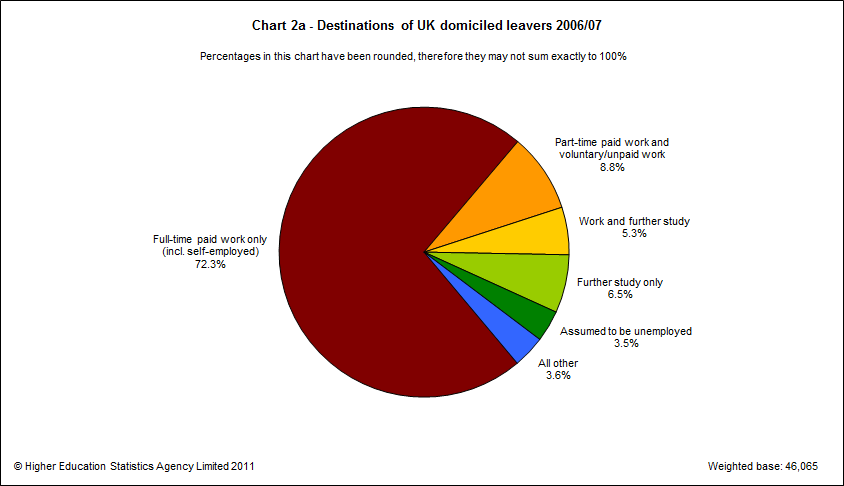

Many institutions in the UK belong to institution mission groups which share similar characteristics. Due to the stratified sample nature of the Longitudinal Survey, response numbers are often too small to be analysed by institution therefore institution groups have been used instead. Chart 3 (sourced from Table 2) compares the main activities of UK domiciled leavers by the mission group of the institution they attended in 2006/07. The percentages engaged in work were similar across the whole sector, whereas the percentage engaged in further study only was much higher for those who had studied at a Russell Group (11.6%) or 1994 group institution (9.1%). Comparisons between mission groups should be interpreted with care due to differences in student populations and the overall teaching and research purposes of institutions in each group. It should also be noted that one institution is a member of two mission groups so these figures include an element of double counting. Table 2 provides more of an in depth breakdown of these figures by domicile and level of qualification. It also shows the differences in activities of leavers by the country of the institution they attended. Among UK domiciled leavers, those who studied in Wales were more likely to be working part-time (11.0%) than those from the other countries.
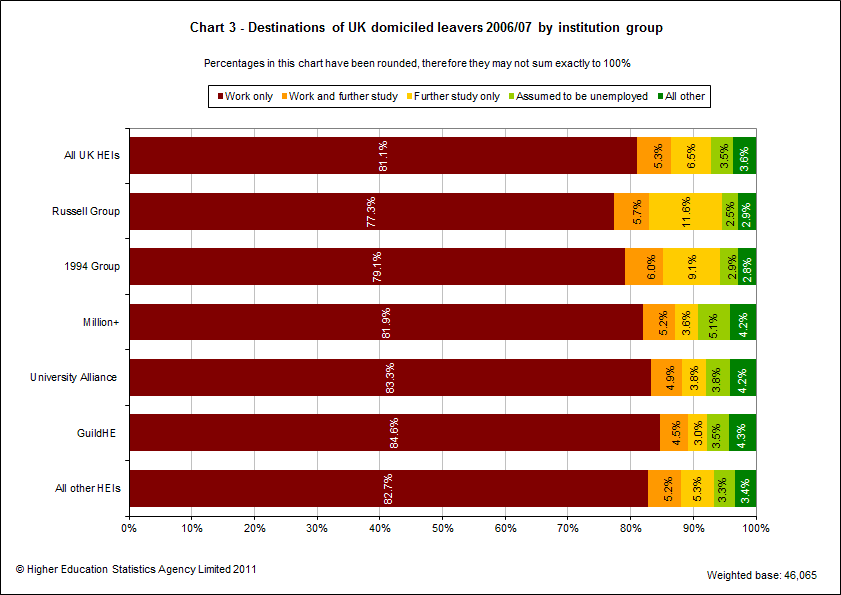
Differences in the main activities of leavers were apparent when analysed by other characteristics as illustrated in Table 3. For all leavers responding there was a higher percentage of male leavers in full-time paid work (76.2%) compared to female leavers (69.3%), however female leavers were less likely to be unemployed (2.9%) compared to 4.5% of male leavers. The proportion of leavers in full-time paid work was similar for those who obtained their qualification on a full-time or part-time basis in 2006/07. However, those who studied part-time were much more likely to be in part-time work (11.7%) than those who studied full-time (7.1%). Other undergraduate leavers had the lowest proportion of leavers in full-time paid work (65.9%) but the highest percentage of leavers in part-time paid work (13.9%). First degree leavers were the most likely to be engaged in further study only (7.9%). Activities of UK domiciled leavers are provided by level of qualification, mode of study and age group in Table 4 and by mode of study, gender and class of first degree in Table 5.
Chart 4 illustrates the activities of UK domiciled leavers by the subject area of the qualification they obtained in 2006/07 (sourced from Table 7). Leavers who studied Medicine & dentistry were most likely to be working at the survey date with 88.9% in work only and they were the least likely to be unemployed (0.7%). The highest percentage of leavers who were engaged in further study only was those who studied Physical sciences (17.4%). Further detail of activities by subject area and level of qualification are provided in Table 7 which shows that the subject area with the highest percentage of leavers indicating they were creating a portfolio were those who studied Creative arts & design (1.6%).
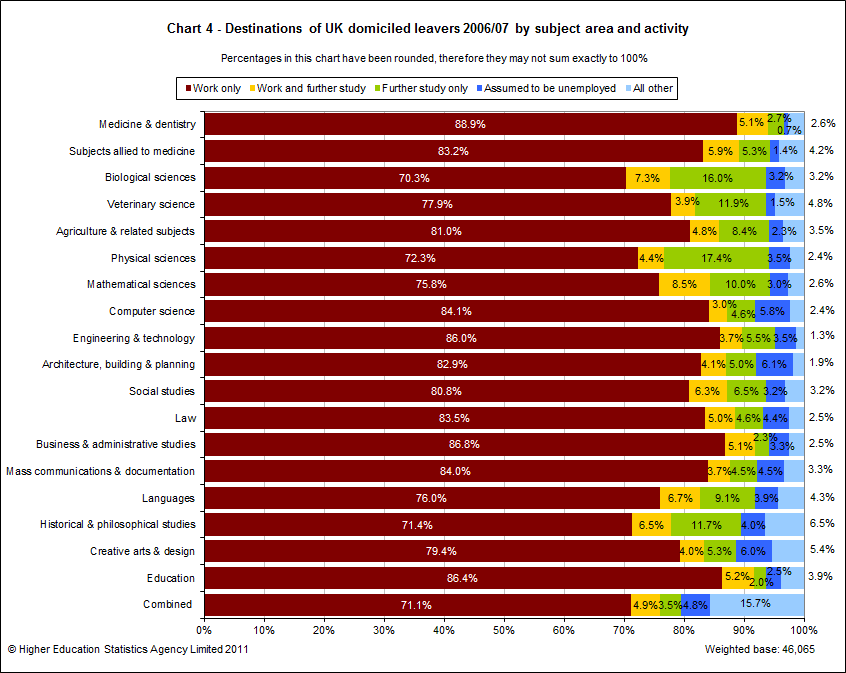
Chart 5 compares the activities of UK domiciled leavers on 29 November 2010 with the activity they were doing at the Early Survey (sourced from Table 6). Across all activities at the Early Survey stage, the majority of leavers were in full-time paid employment 3 years later. 60.6% of those who were assumed to unemployed at the Early Survey were in full-time paid work on 29 November 2010. Almost a third (29.0%) of those in part-time or voluntary work at the Early Survey were still in such work 3 years later.
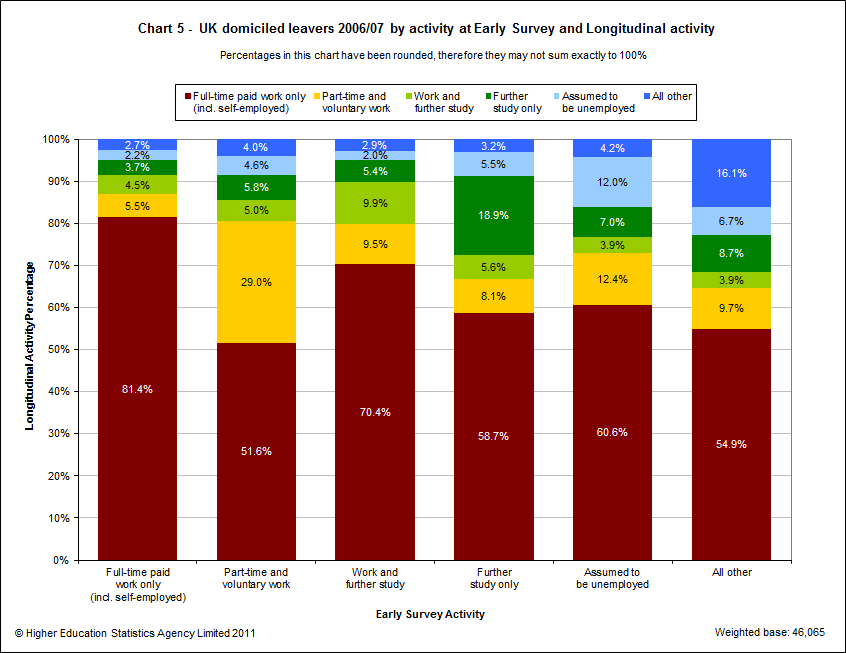
UK Leavers in Employment
This section focused on UK domiciled leavers who were employed (including those who were working and studying) on 29 November 2010. Nearly a quarter (23.5%) of leavers engaged in employment were employed in Education, while a further 19.8% were working in the Health and social work industry. Table 8 provides detailed breakdowns of the Standard Industrial Classifications (SIC) of employed leavers by their subject, mode and level of qualification obtained in 2006/07. As anticipated, the industries that leavers were employed in varied by subject area with the majority of leavers in certain subjects working in industries related to their qualification. 87.1% of employed Medicine & dentistry leavers, 78.6% of Veterinary science and 75.7% of employed leavers from Subjects allied to medicine were working in the health and social work industry. Similarly 81.6% of employed Education leavers were working in Education.
Table 9 provides a similar breakdown for these leavers by their Standard Occupational Classification. 40.5% of UK domiciled leavers in employment were in ‘Professional’ occupations and a further 28.7% were in occupations classified as ‘Associate professional and technical occupations’. These proportions vary by the subject and level of qualification obtained in 2006/07. Over half (57.6%) of employed postgraduate leavers were in ‘Professional’ occupations compared to 36.4% of first degree leavers and 19.8% of other undergraduate leavers.
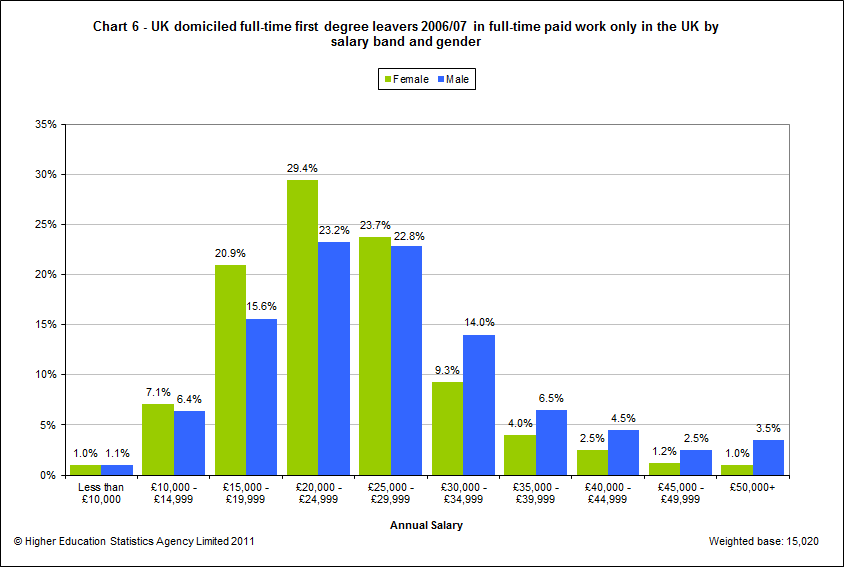
Chart 6 above displays the salary distribution of UK domiciled full-time first degree leavers who were in full-time paid employment in the UK (sourced from Table 10). The median salary for UK domiciled full-time first degree female leavers was £23,295 which had increased from £18,000 at the Early Survey stage. It should be noted that due to the difference in precision of the salary data collected in each survey, the median salaries for the Early survey are calculated to the nearest £500 whereas those for the Longitudinal survey are calculated to the nearest pound. UK domiciled full-time first degree male leavers experienced a similar increase from a median salary of £20,000 at the Early Survey stage to £25,000 reported on 29 November 2010. Further detailed salary figures can be viewed in Table 10. Table 11 shows similar salary information disaggregated by subject and level of qualification obtained in 2006/07. Across all first degree leavers the largest median salary was observed for UK domiciled leavers in full-time employment who had studied Medicine & dentistry (£40,000) which had increased from £29,000 at the Early Survey stage, a 38% increase. The largest percentage increase (55%) in median salary was observed for postgraduate leavers who studied Law increasing from £20,000 at the Early survey to a median of £31,000 three years later. Other large percentage increases in median salaries were observed among first degree leavers in Biological sciences (£16,000 to £22,000, a 38% increase) and first degree Creative arts & design leavers (£15,000 to £20,500, a 37% increase).
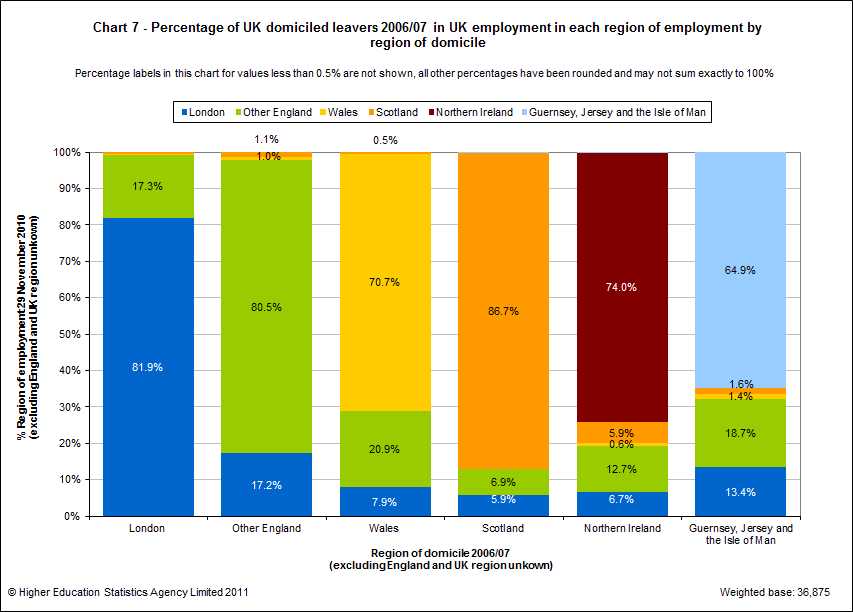
Linking leavers’ responses to both their HESA Student record data and they Early Survey activities enables analysis of the movement of leavers across UK regions. Chart 7, Chart 8 and Chart 9 show the region of employment patterns for UK domiciled leavers in UK employment by region of domicile on entering HE, region of institution and region of employment at the Early Survey (sourced from Table 12, Table 13, and Table 14).
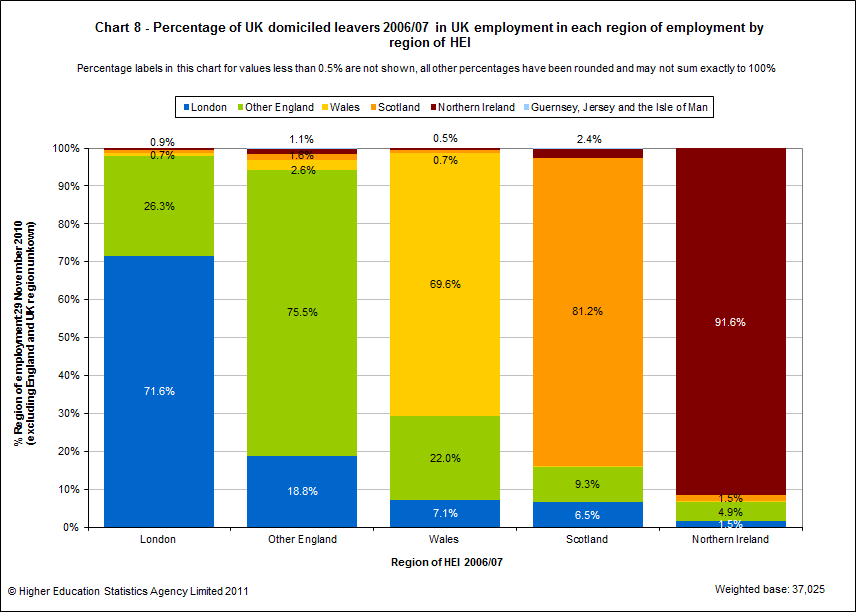
The majority of leavers who were employed at the Early survey and were also working 3 years later remained in the same region. From other areas of England the greatest migration of working leavers was into London (8.9%).
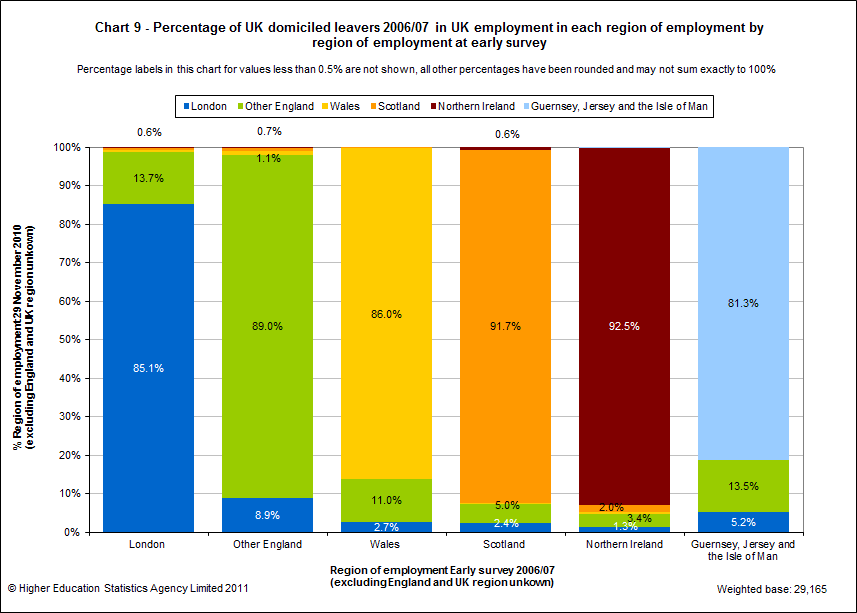
All leavers in employment on 29 November 2010 were asked to consider how important they felt certain factors about the course they undertook were to their employer when gaining the job they were doing on the census date. Table 15 breaks down the responses to these questions by level of qualification and subject area. Generally, leavers indicated that the type of qualification they gained and the subject studied were either a formal requirement or were important to their employer. 37.8% of UK domiciled leavers in employment indicated that the type of qualification they gained was a formal requirement and a further 28.4% indicated that it was important. Similarly 34.8% indicated that the subject they studied was a formal requirement and a further 28.2% that it was important. Chart 10 below shows leavers’ responses to this question by the subject they studied. Leavers who studied more vocationally-orientated subjects were much more likely to indicate that the subject was a formal requirement when gaining their job than those who studied subjects with less specific career pathways.
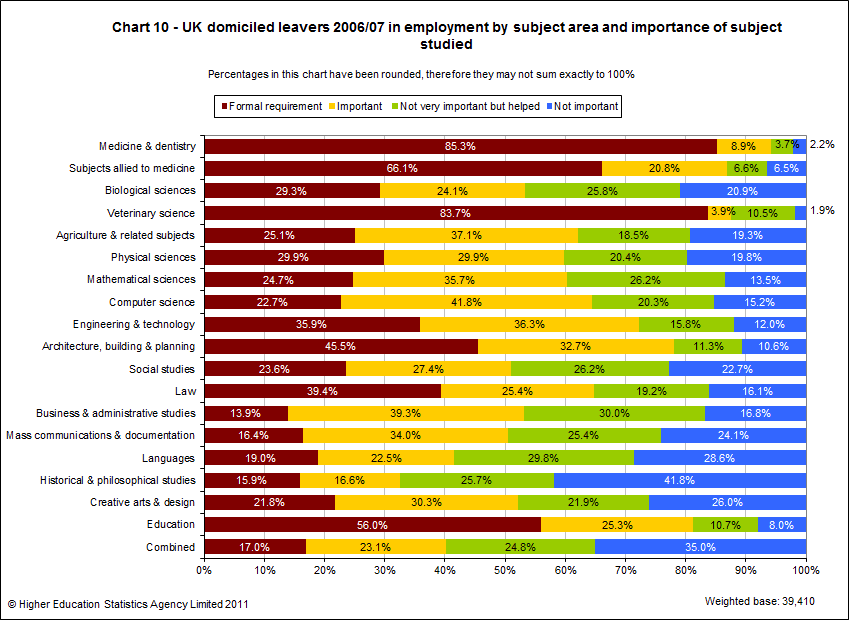
Further Study
5,880 leavers were engaged in either further study or work and further study on 29 November 2010. Chart 11 below shows the level of qualification that first degree leavers were aiming for (sourced from Table 16). Nearly a third of first degree leavers were aiming for a higher degree by research (30.8%).
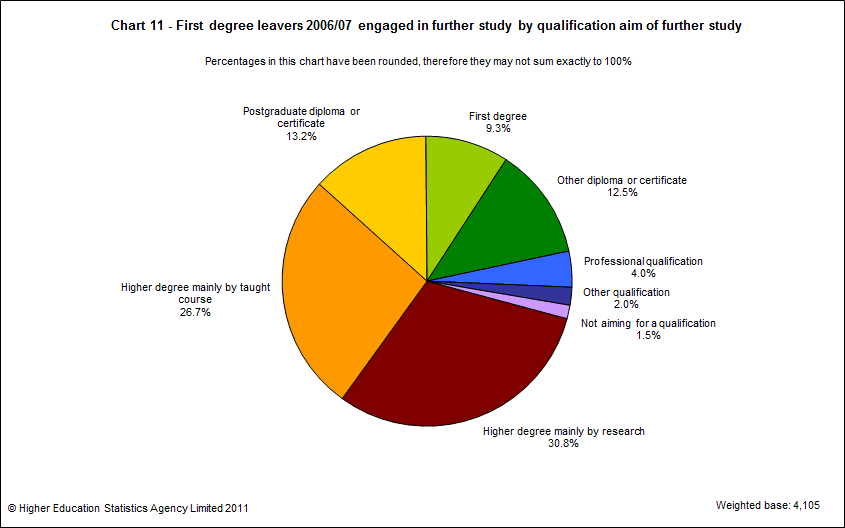
When analysed by various factors, differences are apparent in the qualification aims of leavers who were engaged in further study which can be seen in Table 16. The majority of postgraduate taught leavers (60.4%) were aiming for a higher degree mainly by research. Over two thirds of first degree leavers were aiming for a postgraduate degree and 40.9% of other undergraduate leavers were aiming for a first degree. There were also differences by region of institution attended in 2006/07 and institution group. Nearly a fifth (18.2%) of leavers from institutions in Northern Ireland were aiming for a professional qualification whereas institutions in England and Scotland had the highest proportions of leavers going on to study for a higher degree mainly by research (36.2% and 36.0%, respectively). Leavers from Russell Group institutions were most likely to be studying for a higher degree mainly by research (51.1%). The largest percentage of leavers going on to study for professional qualifications was observed amongst those who had studied at Million+ institutions (12.5%).
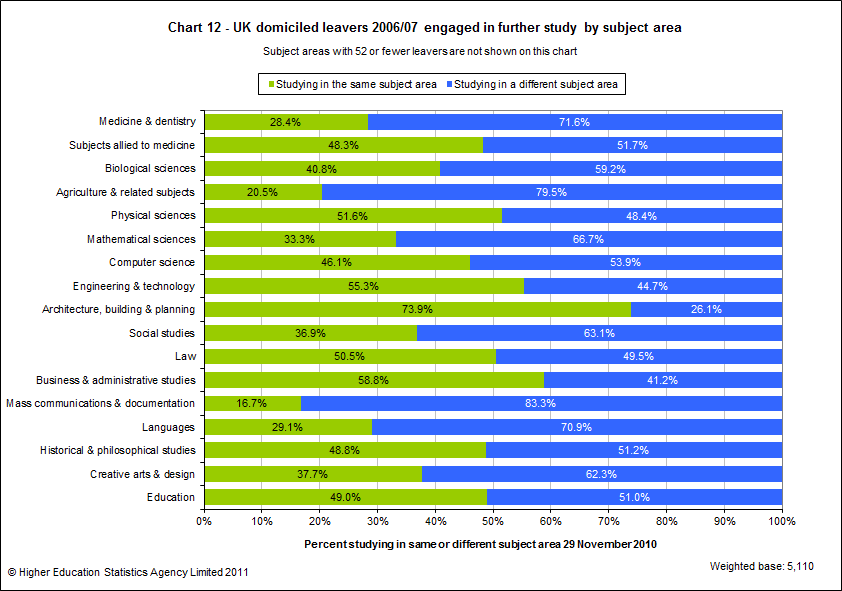
For all those in either further study or work and further study Chart 12 above (sourced from Table 17) compares the subject area of the qualification obtained by UK domiciled leavers in 2006/07 with the subject area that they were studying on 29 November 2010. Nearly three quarters (73.9%) of Architecture, building & planning leavers who were engaged in further study were studying in the same subject area 3 years later. It should be noted that it is a requirement to complete a further qualification before leavers become qualified architects. Less than a third (28.4%) of Medicine & dentistry leavers were studying this same subject area, however it should be noted that 32.5% were studying Subjects allied to medicine. The most common subject area for further study was Education (14.7%) which attracted varying proportions from subject areas other than Education, most notably 24.2% of Creative arts & design leavers were studying Education as were 23.0% of Mass communications & documentation leavers.
All leavers were asked about any further qualifications that they had obtained since the qualification they gained in 2006/07. 18,215 leavers indicated that they had gone on to achieve another qualification. Chart 13 below summarises these responses by the level of the qualifications obtained (sourced from Table 18).
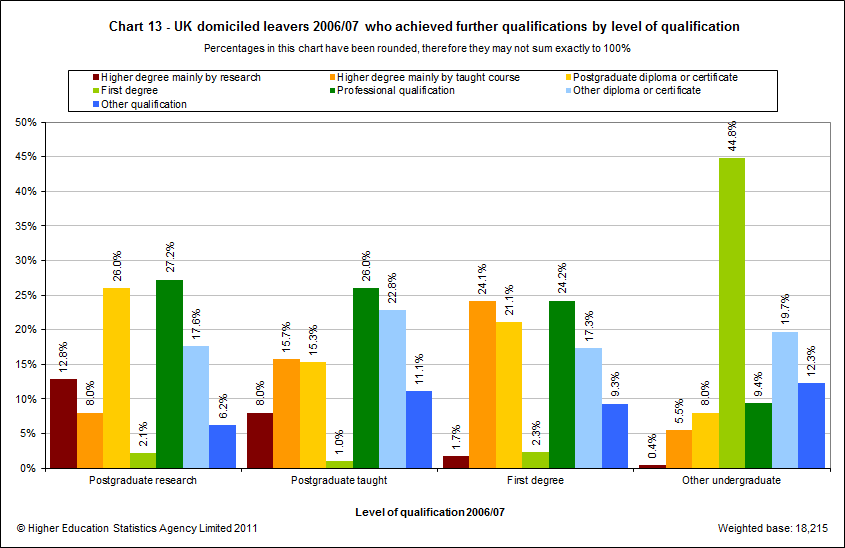
The majority of undergraduate leavers who had gone on to obtain another qualification had gained a qualification at a higher academic level than the one they obtained in 2006/07. Chart 13 also highlights that around a quarter of leavers who obtained a first degree or higher then went on to gain some type of professional qualification. Table 18 provides more detail by level of qualification, gender and institution group and region.
Satisfaction and Higher Education experience
The final section of the questionnaire asked all leavers a set of questions about their experience of higher education and their satisfaction with their career to date. Chart 14 below summarises leavers’ responses to a question about how likely it was that they would change aspects of the course that they completed in 2006/07 (sourced from Table 19). Leavers were asked to consider the subject of study, the institution, the qualification type and whether they would chose to do something other than study or research.
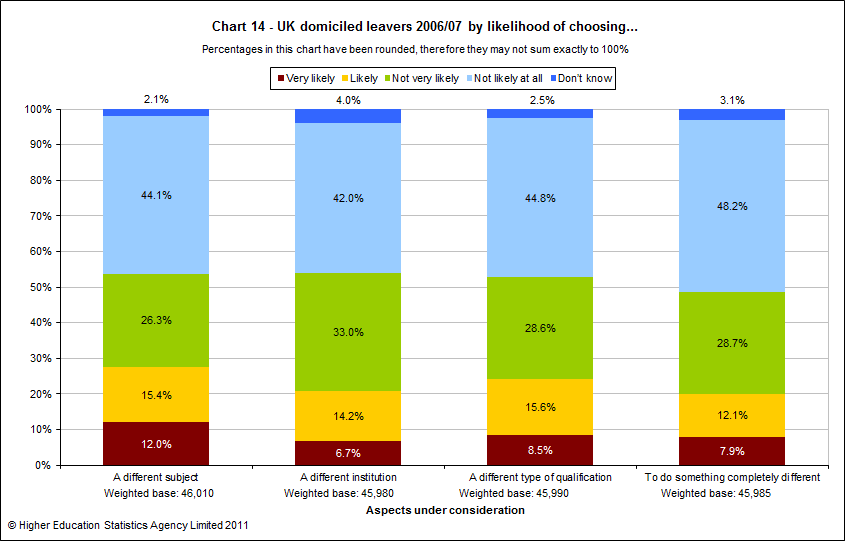
In general leavers felt that it was ‘Not very likely’ or ‘Not likely at all’ that they would change the course that they completed in 2006/07. Table 19 provides a more detailed breakdown of these responses by level of qualification, gender, institution group and subject area. The most variation in responses was observed when analysed by subject area.
Chart 15 below (sourced from Table 20 and Table 21) displays the responses to the questions about whether or not leavers were satisfied with their career to date, their views about whether or not their course was good value for money and if their higher education experience prepared them for their career or for being self-employed.
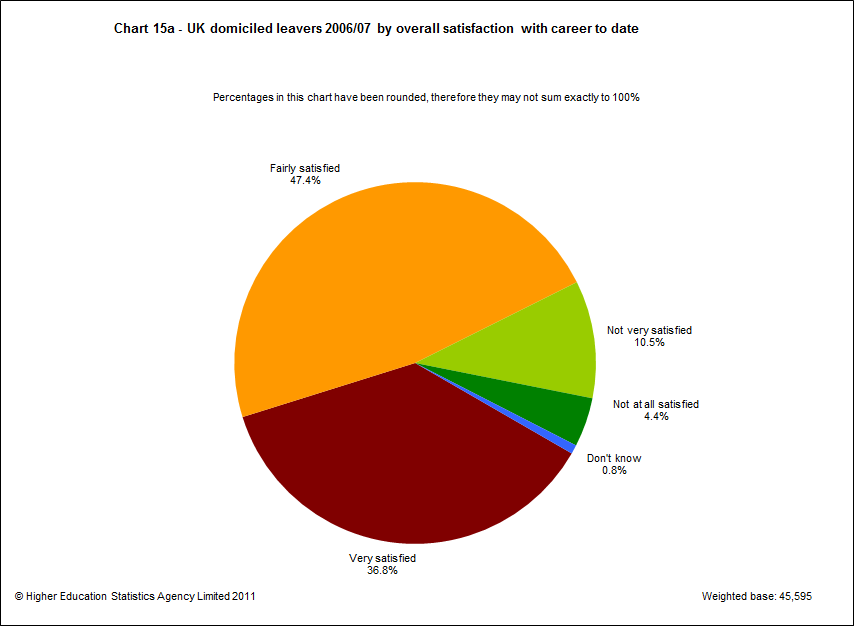
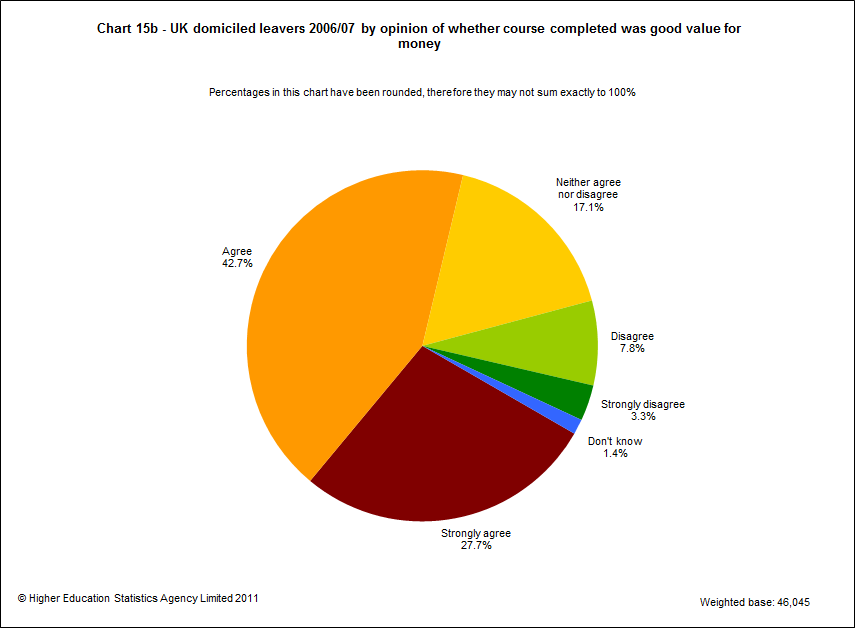
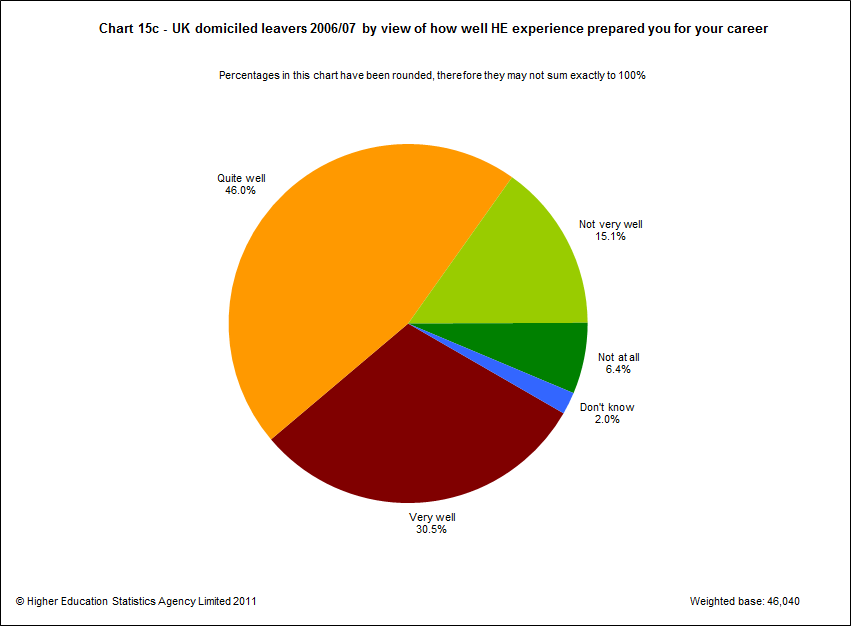
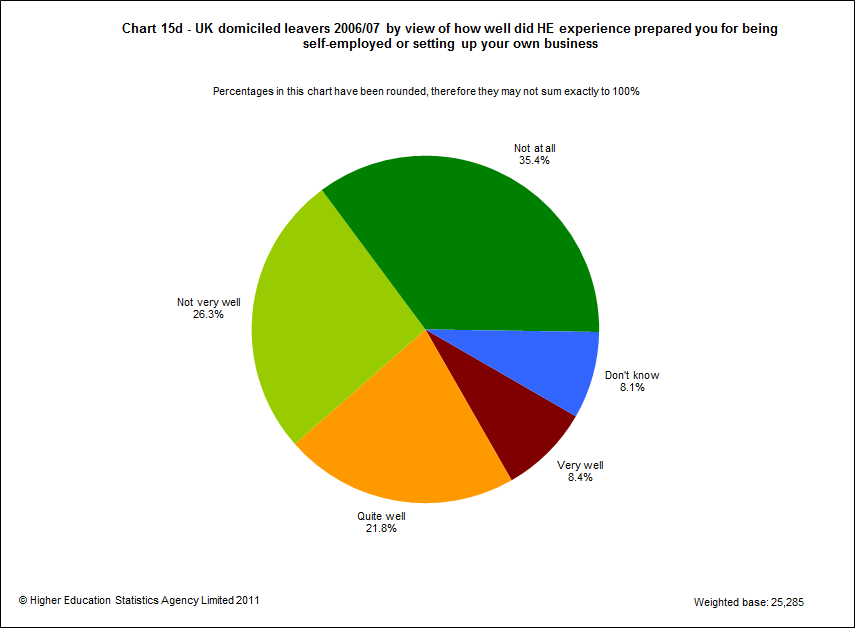
Table 20 and Table 21 provide more detail by level of qualification, gender, subject of qualification and activity on 29 November 2010. For all questions the most variation in responses was observed across subject areas and activities on the survey date. In general female leavers were slightly more likely to say they were ‘Very satisfied’ with their career to date (38.4%) compared to male leavers (34.6%) although nearly half of male leavers (49.3%) said they were ‘Fairly satisfied’ compared to 46.1% of female leavers.
